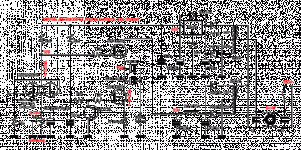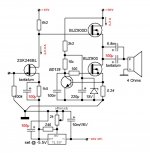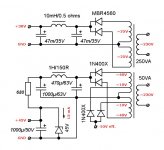Daniel,
Nice circuit, nothing too unexpected.....
Could you describe the sound? Tubelike would describe it?
You have the usual Vgs distortion of the SE source follower.
Could I suggest something? A simple emitter follower regulator with heavily decoupled zener for reference on the input stages rather than the chip; in my experience it sounds better, more vitality....
Cheers,
Hugh
Nice circuit, nothing too unexpected.....
Could you describe the sound? Tubelike would describe it?
You have the usual Vgs distortion of the SE source follower.
Could I suggest something? A simple emitter follower regulator with heavily decoupled zener for reference on the input stages rather than the chip; in my experience it sounds better, more vitality....
Cheers,
Hugh
Of course, trans is better solutionAKSA said:
...Could I suggest something? A simple emitter follower regulator with heavily decoupled zener for reference on the input stages rather than the chip; in my experience it sounds better, more vitality....
Cheers,
Hugh
Yesterday, when I made the prototype, I had only two 20V zeners on hand
Sound is deep and very fast with tight bass and bright mid and high freqs.
Output power is 17-18 watts (there is a mistake in attachment).
Signal (top) 1529 has current regime between 0.5 and 6.5A for full power(Imin and Imax) and dissipates 52-53 watts.
Because of too many business trips abroad during last several years,
I was inactive for a very long time (from the end of 2007th i think).
I want to share with you one of my ideas, which is in fact the next step of this very simple design.
Actually this is an old design, I made it 6 years ago, but I didn't post it at that time...
Also (at the same time) I made some tests, using full range driver Ether 6, mounted in backloaded horn enclosure.
The amp has most of advantages of tube SE amps, OK, not all of them,
but it sounds great - with monumental, huge bass and more than enough "air between the notes"
The most important disadvantage is its prone to generate a wide harmonics spectrum,
which is tangible especially when listening poor quality records.
So, the schematic is very simple - first stage is common source with 2SK246BL - it makes all of voltage amplification of the amp.
The second stage is current follower (common drain), realized with one of best audio MOSFETs - Hitachi 2SK1056/7/8,
with constant current source, connected to its source.
Input stage is supplied more complicated - it has positive one +45V and the other one (negative),
which is ajustable and keeps the current of input transistor relatively stable in very wide temperature range.
The output stage is directly coupled to the input one. The idea is to get almost the same temperature drift for both stages,
i.e. to get zero offset (actually 1/2 Vdd) for wide temperature range (let's say something like 20-100°C).
I was inactive for a very long time (from the end of 2007th i think).
I want to share with you one of my ideas, which is in fact the next step of this very simple design.
Actually this is an old design, I made it 6 years ago, but I didn't post it at that time...
Also (at the same time) I made some tests, using full range driver Ether 6, mounted in backloaded horn enclosure.
The amp has most of advantages of tube SE amps, OK, not all of them,
but it sounds great - with monumental, huge bass and more than enough "air between the notes"
The most important disadvantage is its prone to generate a wide harmonics spectrum,
which is tangible especially when listening poor quality records.
So, the schematic is very simple - first stage is common source with 2SK246BL - it makes all of voltage amplification of the amp.
The second stage is current follower (common drain), realized with one of best audio MOSFETs - Hitachi 2SK1056/7/8,
with constant current source, connected to its source.
Input stage is supplied more complicated - it has positive one +45V and the other one (negative),
which is ajustable and keeps the current of input transistor relatively stable in very wide temperature range.
The output stage is directly coupled to the input one. The idea is to get almost the same temperature drift for both stages,
i.e. to get zero offset (actually 1/2 Vdd) for wide temperature range (let's say something like 20-100°C).
Last edited:
Ooops,
I typed mistakenly "current follower" instead of "source follower". Also I forgot to attach schematic.
(characteristics and linearity of BUZ900 are identical with 2SK1058 data).
I typed mistakenly "current follower" instead of "source follower". Also I forgot to attach schematic.
(characteristics and linearity of BUZ900 are identical with 2SK1058 data).
Attachments
Last edited:
- Status
- This old topic is closed. If you want to reopen this topic, contact a moderator using the "Report Post" button.


